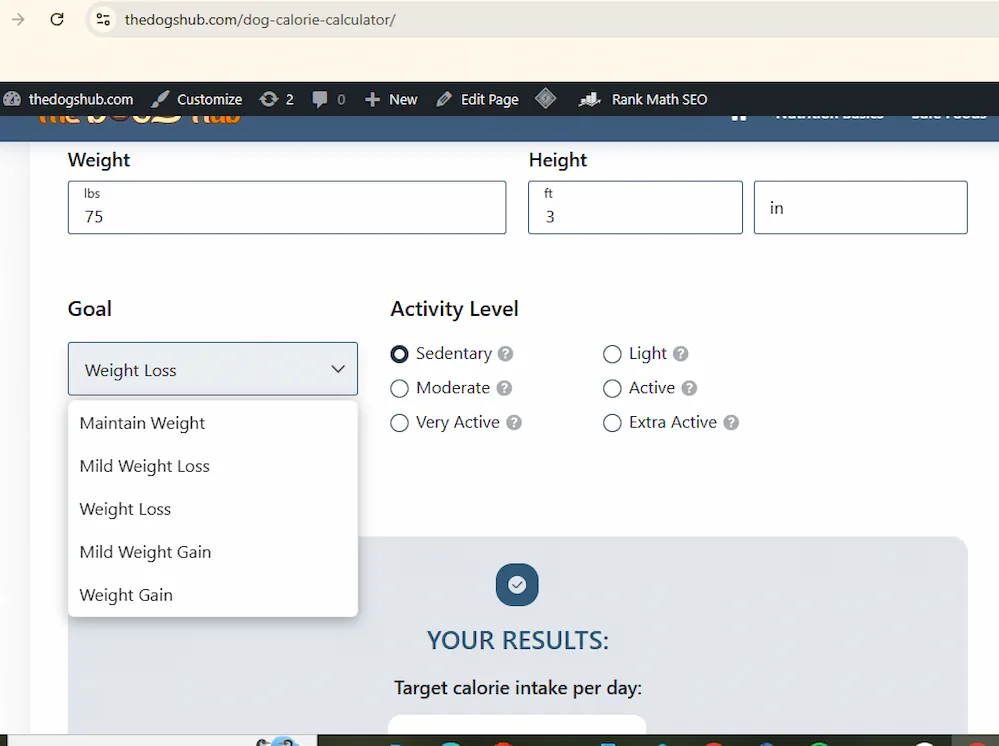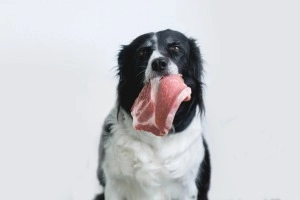How to Help My Dog Lose Weight – 7 Proven Ways That Actually Work
Published: 26 Apr 2025
According to the Association for Pet Obesity Prevention (APOP)‘s 2022 report, over 55% of dogs in the U.S. are classified as overweight or obese, highlighting a growing concern for their health. This obesity can lead to serious health issues, such as joint problems, heart disease, and diabetes, all of which affect your dog’s energy, mobility, and overall well-being.
Fortunately, these issues can be prevented with a proper weight loss plan. As a veterinarian with over four years of experience in canine nutrition, I’ll explain seven scientifically proven ways to help your dog lose weight safely and effectively.
1. Start with a Vet Consultation
A vet consultation is an essential first step in your dog’s weight-loss journey. Your veterinarian will help determine your dog’s baseline weight—the ideal weight based on their age, breed, and size. This provides a clear starting point for your weight-loss goals and helps monitor progress safely.
They will assess your dog’s current health status and check for any underlying health issues, such as hypothyroidism, diabetes, or joint problems, which could contribute to weight gain.
A vet will also help you understand any breed-specific obesity risks. For example, Labrador Retrievers and Beagles are prone to overeating, while Dachshunds and Bulldogs may have a harder time losing weight due to their body structure. They will guide you in adjusting your dog’s diet and exercise plan accordingly.
2. Precise Portion Control and Monitoring Daily Calorie Intake
Monitoring your dog’s daily calorie intake ensures they receive the right amount of food for losing weight__ neither too few nor too much. Consistently use a measuring cup or a kitchen scale to serve the precise amount of food recommended by your veterinarian.
A study published in the International Journal of Obesity concludes that portion control is an important aspect of weight management. By implementing strategies to moderate intake, individuals can better manage their energy intake and support a healthy body weight.
To refine your approach, consider utilizing a free dog calorie calculator. These tools help estimate your dog’s daily caloric needs based on their weight goal.

You can also use our helpful feeding charts to guide you:
- Senior Dog Feeding Chart by Age and Weight
- Puppy Feeding Chart by Age and Weight
- Adult Dog Feeding Chart by Age and Weight
For more detailed information on portions and how much your dog should eat, check out our guide “How Much Food Your Dog Should Eat” or “How Many Calories Does a Dog Need.”.
3. Stick to a Consistent Feeding Schedule
Establishing a consistent feeding schedule is an important step in helping your dog lose weight. Dogs are creatures of habit, and sticking to a routine signals to their bodies when it’s time to eat, which can improve digestion and nutrient absorption. A study shows that dogs who eat daily at the same time have better digestion, a stable heart rate and blood pressure, and a healthy immune system.
To help you stay on track, read our post “How Often Should a Dog Eat“.
4- Choose a Dog Weight Loss Vet-Recommended Diet
Veterinarian-recommended weight loss diets are carefully balanced to be low in calories and fat yet rich in protein and fiber. The increased fiber content helps your dog feel fuller for longer, making it easier to manage their calorie intake. Furthermore, the focus on protein helps maintain lean muscle mass while your dog sheds excess pounds, which is crucial for a healthy metabolism and long-term weight management success.
A study published in the Journal of the American Veterinary Medical Association concluded that continued feeding of the weight-loss food after the initial caloric restriction phase can be beneficial for maintaining healthy body weight and overall health in overweight dogs.
5- Make Exercise a Daily Routine
Exercise plays a significant role in weight loss because it burns calories, builds muscle, and keeps your dog fit and happy. Here are some dog-friendly workouts that can make a big difference:
- Walks: One of the simplest and most effective exercises for weight loss in dogs is a brisk walk. Aim for at least 30 minutes a day, which can be broken into two shorter walks if necessary.
- Tug-of-War: This fun, interactive game helps burn calories and engages your dog’s muscles. It’s a great indoor option for energetic dogs and can be tailored to their strength and energy level.
- Agility: If you have space, setting up a small agility course in your backyard is a fun way to get your dog moving. Agility exercises improve coordination and build strength while providing mental stimulation.
Same study conducted in the Journal of the American Veterinary Medical Association shows that combining exercise with a controlled diet not only helps dogs preserve muscle mass but also supports effective weight loss in overweight and obese dogs.
6. Cut Back on Treats and Table Scraps
One of the easiest ways to help your dog lose weight is to reduce extra calories from treats and table scraps. Many dog treats are high in fat and calories—even small ones can add up quickly. Instead of cutting out treats completely, switch to healthier options like plain green beans, apple slices, banana, strawberries, or air-popped popcorn with no butter.
7- Schedule Regular Vet Checkups
Regular vet checkups are a crucial part of any successful weight loss plan for your dog. While you can monitor their progress at home, having a professional veterinarian ensures that your dog is losing weight at the right pace and that their health is being properly managed throughout the process.
- Body condition score: This helps determine if your dog is losing weight at a healthy rate.
- Muscle mass: A vet can check if your dog is losing fat while maintaining muscle mass, which is crucial for energy and mobility..
- Vital health signs: The vet can monitor other important factors like hydration, blood work, and potential underlying health conditions that might affect weight loss.
Final Thoughts
Helping your dog lose weight is truly a team effort. It requires consistent commitment from you, your family, and your vet. Every small step you take—whether it’s tracking progress, adjusting portions, or sticking to a regular exercise routine—adds up over time, and those efforts will pay off.
Remember, consistency is key. It’s important to be patient and celebrate every small win along the way. Whether it’s seeing a couple of pounds lost, getting positive feedback from the vet, or noticing your dog is more energetic, these wins matter!
FAQs
While it’s natural to want to see quick results, rapid weight loss is generally not safe or sustainable for dogs. Be patient and consistent with the plan your vet provides. Gradual weight loss is the safest and most effective way to help your dog reach a healthy weight and maintain it.
No, fasting is not a safe or effective method to help your dog lose weight. Dogs need regular meals to maintain stable blood sugar levels and proper digestion. Instead of skipping meals, focus on feeding smaller portions based on your dog’s ideal weight, choosing a low-calorie, nutrient-rich dog food, and including light daily exercise like walking or interactive play. Always consult your veterinarian before starting any weight loss plan to ensure your dog stays healthy throughout the process.
A healthy weight loss goal for most dogs is to lose about 1–2% of their body weight per week. This pace is safe and allows the body to adjust gradually without risking muscle loss or nutrient deficiencies. For example, if your dog weighs 50 pounds, a safe weight loss would be around 0.5 to 1 pound per week.
It can take a few weeks to several months for a dog to lose weight, depending on how much weight they need to lose and how consistent you are with their diet and exercise plan.
After neutering, many dogs experience a drop in metabolism and a rise in appetite, which can lead to weight gain. To help your dog lose weight after neutering, consider switching to a lower-calorie food if necessary and reducing the frequency of treats. Add daily walks and active play to help your dog burn calories and stay fit.

- Be Respectful
- Stay Relevant
- Stay Positive
- True Feedback
- Encourage Discussion
- Avoid Spamming
- No Fake News
- Don't Copy-Paste
- No Personal Attacks

- Be Respectful
- Stay Relevant
- Stay Positive
- True Feedback
- Encourage Discussion
- Avoid Spamming
- No Fake News
- Don't Copy-Paste
- No Personal Attacks





